A Fine Pavise, circa 1480
Housed: Wiener Bürgerliche Zeughaus, Vienna
Published: Das Wiener Bürgerliche Zeughaus
Photo copyright: Unknown
[ Linked Image ]
Click for detailed version
Pavise, circa 1451-1500
Housed: Germanischen Nationalmuseum, Nuremberg, W974
Photo copyright: Germanischen Nationalmuseum, Nuremberg
[ Linked Image ]
Click for detailed version
A Bohemian Pavise, circa 1480
Housed: Unknown
Published: Unknown
Photo copyright: Unknown
[ Linked Image ]
Click for detailed version
A Bohemian Pavise, Late 15th Century
Housed: National Museum, Prague
Published: Unknown
Photo copyright: Unknown
[ Linked Image ]
Click for detailed version
A Bohemian Pavise, circa 1450
Housed: Deutsches Historisches Museum, Berlin
Published: Unknown
Photo copyright: Deutsches Historisches Museum, Berlin
[ Linked Image ]
Click for detailed version
A German Pavise, circa 1480-1490
Housed: Deutsches Historisches Museum, Berlin
Published: Unknown
Photo copyright: Deutsches Historisches Museum, Berlin
[ Linked Image ]
Click for detailed version
I'm currently going through some old books about arms and armour, and I think this is related to this topic. I believe we still lack even a single picture of a hand pavise.
 Attachment: 129.44 KB
Attachment: 129.44 KB
[ Download ]
[ Download ]
Here is a picture of a hussite pavise I just finished.
http://i204.photobucket.com/albums/bb280/amthanna/pavise1.jpg
Mark
http://i204.photobucket.com/albums/bb280/amthanna/pavise1.jpg
Mark
nice mark! can i put the first ding in it this weekend?
Nothing that sawdust and some good woodglue cannot fix, perhaps even wood putty right :D
Mark that does look awesome! Nice work. Got a nice flail to go along with it? I am looking at finding some wood to make a 'war club' for a project in the near future.
I really have enjoyed this post. While everyone focuses much on the armour at Agincourt to Fodden etc. in many accounts the pavaise is listed as one key factor in deflecting/defeating arrows. Clearly this item was viewed as somewhat important by chroniclers and soldiers as well.
Lovely thread.
RPM
Mark that does look awesome! Nice work. Got a nice flail to go along with it? I am looking at finding some wood to make a 'war club' for a project in the near future.
I really have enjoyed this post. While everyone focuses much on the armour at Agincourt to Fodden etc. in many accounts the pavaise is listed as one key factor in deflecting/defeating arrows. Clearly this item was viewed as somewhat important by chroniclers and soldiers as well.
Lovely thread.
RPM
Didn't quite get the flail done, but I have a pistola to keep Chuck at bay. Still not sure about the border, its a simplified version of a 1440's bohemian pavise. It looks a little more like a manuscript boarder or a nordic sweater. It will have to do for now.
Mark
Mark
| Kel Rekuta wrote: | ||
Yeah, its like an Osprey Book, nice pictures little substance. No footnotes, no bibliography. A single page list of sources. The illustration by Robert Nicholls is on pg 23. Looks more like a Roman scutem than anything else. |
A word of warning on the Osprey books, from chatting to Charles it appears that the artist consulted Charles a grand total of 0 (zero) times. The pictures are mildy dubious, to be polite..
Very nice!
I remember back when I was on the East Coast studying stage combat with Brad Waller and occasionally David Doersch, we did a sword & Buckler class and someone had a few bucklers that were based on some from Marozzo's Pressas, in a style very obviously evolved from some of those one hand Pavises. Not sure who made 'em though.
[ Linked Image ]
Arms & Armor makes one:
[ Linked Image ]
I remember liking how you could kinda 'hook' and catch blades with it in a way that round, convex bucklers couldn't.
I remember back when I was on the East Coast studying stage combat with Brad Waller and occasionally David Doersch, we did a sword & Buckler class and someone had a few bucklers that were based on some from Marozzo's Pressas, in a style very obviously evolved from some of those one hand Pavises. Not sure who made 'em though.
[ Linked Image ]
Arms & Armor makes one:
[ Linked Image ]
I remember liking how you could kinda 'hook' and catch blades with it in a way that round, convex bucklers couldn't.
Here are more pavises, from the Historisches Museum der Stadt Wien. From the book Wehrhafte Stadt: Das Wiener Buergerliche Zeughaus im 15. und 16. Jahrhundert.
There are actually probably another 10 pavises pictured in colour in this book (and more in small B&W pics), but these are the best of the bunch.
 Attachment: 71.59 KB
Attachment: 71.59 KB
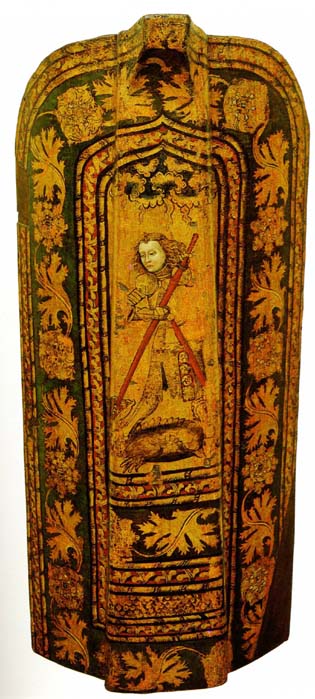
 Attachment: 79.27 KB
Attachment: 79.27 KB
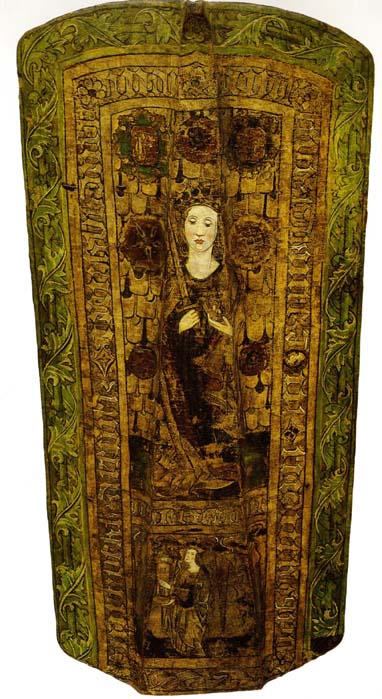
 Attachment: 95.96 KB
Attachment: 95.96 KB
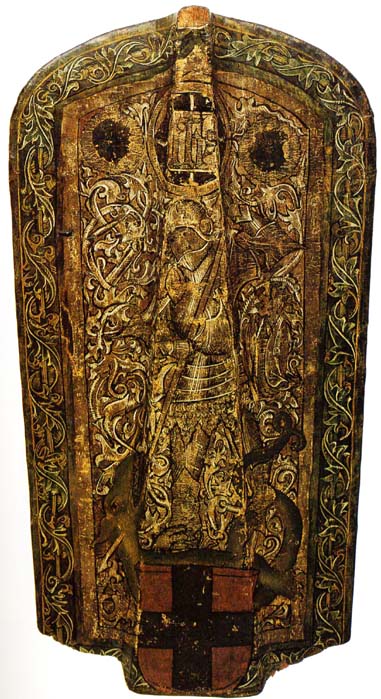
 Attachment: 64.61 KB
Attachment: 64.61 KB
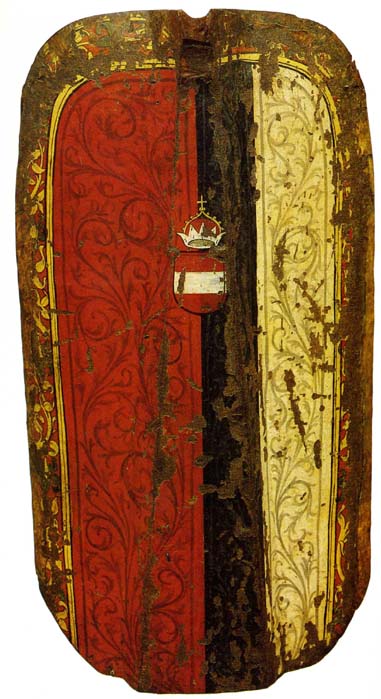
 Attachment: 67.9 KB
Attachment: 67.9 KB
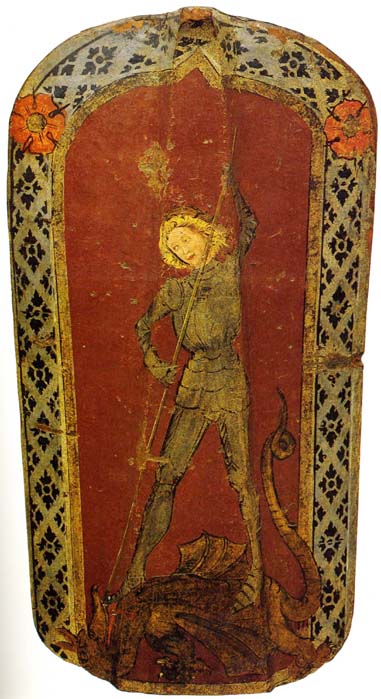
 Attachment: 90.83 KB
Attachment: 90.83 KB
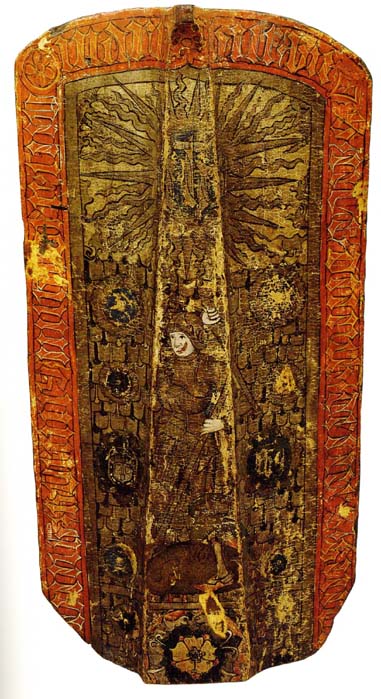
There are actually probably another 10 pavises pictured in colour in this book (and more in small B&W pics), but these are the best of the bunch.






One more pavise shield is here. This is the real example from collection of Artillery museum in St. Petersburg. Visitors are not allowed to take pictures at that particular exhibition. Fortunately I was allowed to take a picture with the cell phone camera. That’s why the quality of that pictures isn’t high.
 Attachment: 141.16 KB
Attachment: 141.16 KB
...... [ Download ]
...... [ Download ]
I see a lot of good information on dimensions and construction, but I would like to know if anyone knows how much a pavise would weigh, depending on period, of course?
Check out the mega-pavise here. :)
 Attachment: 88.29 KB
Attachment: 88.29 KB
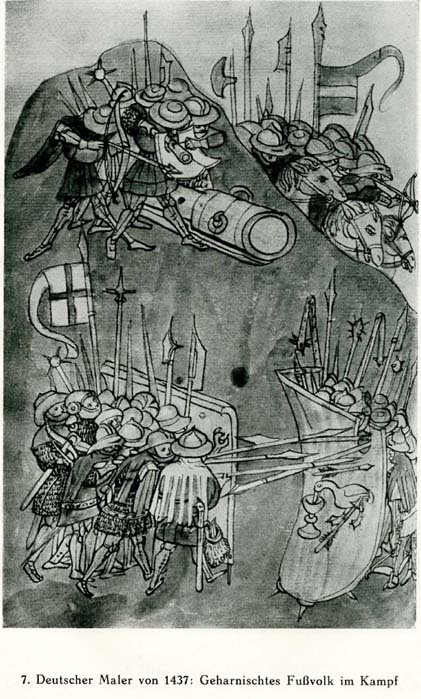
 Attachment: 74.34 KB
Attachment: 74.34 KB
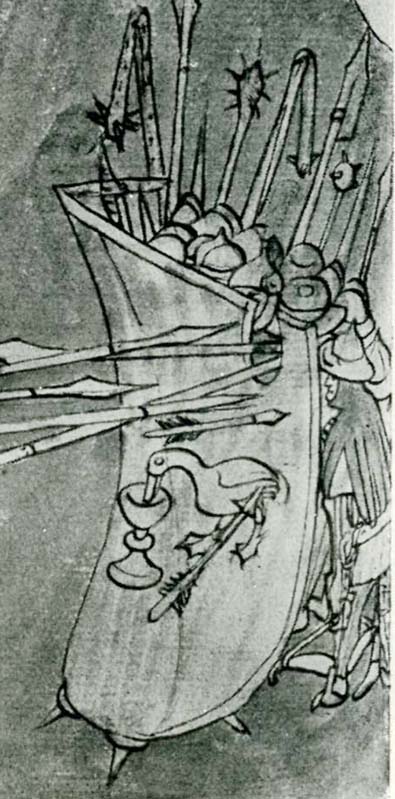
Detail


Detail
Here are some pavises from the Metropolitan Museum of Art. Photos by me (sorry!).
 Attachment: 78.42 KB
Attachment: 78.42 KB
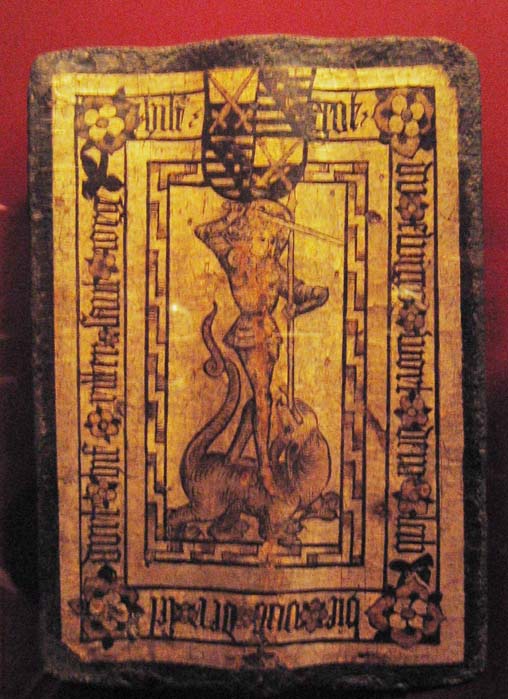
Hand pavise.
 Attachment: 24.36 KB
Attachment: 24.36 KB
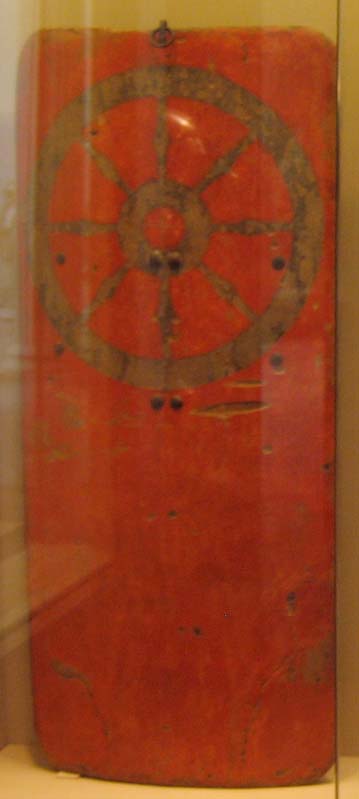
Another pavise
 Attachment: 36.12 KB
Attachment: 36.12 KB
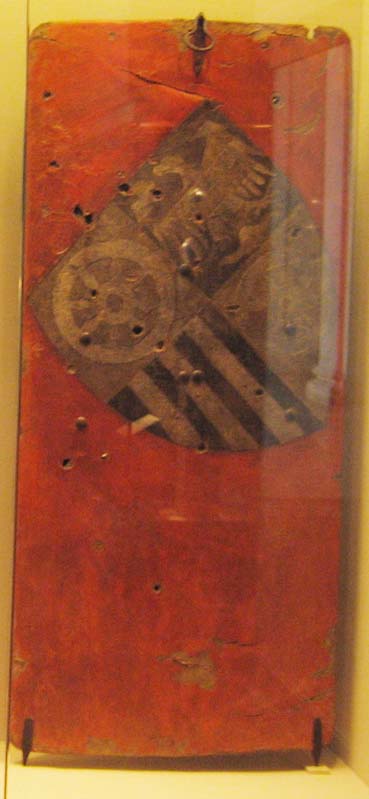
Pavise
 Attachment: 34.8 KB
Attachment: 34.8 KB
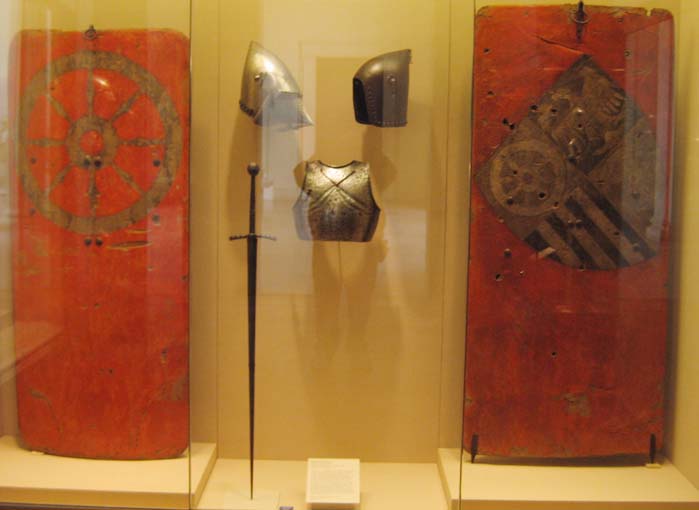
Pavises in their cases for scale. That sword is about 4 feet long!

Hand pavise.

Another pavise

Pavise

Pavises in their cases for scale. That sword is about 4 feet long!
On the large pavises, there are many examples with central spine and a beak-like projection. Does anyone know what the function of that "beak" would be? I can imagine why the central spine/ridge makes sense, but that little beak makes my brain itch with curiosity...
would dueling shields be a sort of pavise as well?
| Bjorn Hagstrom wrote: |
| On the large pavises, there are many examples with central spine and a beak-like projection. Does anyone know what the function of that "beak" would be? I can imagine why the central spine/ridge makes sense, but that little beak makes my brain itch with curiosity... |
Completely uneducated guess here but it looked to me like the ridge and beak might be some sort of interlocking system to place a third pavise on top of two others to form a ceiling?
In some other pictures ( like the last few in this post ) there are a few specimens with what look like hooks or rings protruding from the top center of the pavise, my first thought when I saw them was if the ring or hook in the center of the top of two separate pavises was used to seat the spikes on either side of the bottom of a third then you could have a more versatile construction block for defense, using it as either a larger vertical wall or possibly angling the top row back to form a roof.
Just brainstorming , I'm not a professor or anything - but I am also interested in these medieval multi tools.
| Chad Arnow wrote: |
| Check out the mega-pavise here. :) |
Fantastic illustration. Where did you find this image? Do you know if those are supposed to be Hussites behind the large pavise with the 'bouche' cut out? The chalice painted on the shield and the war flails make me think so.
| James Head wrote: |
| Fantastic illustration. Where did you find this image? |
I believe it was the old Bruno Thomas book Harnische. The book is in German, so I can't tell you a lot about it. :) Some neat pictures, though.
I have heard second (or third) hand that the word Pavise comes from the town of Pavia in Italy and that their cottage industry was the shield. Is there any truth to this?
| Adam O'Byrne wrote: |
|
Completely uneducated guess here but it looked to me like the ridge and beak might be some sort of interlocking system to place a third pavise on top of two others to form a ceiling? In some other pictures ( like the last few in this post ) there are a few specimens with what look like hooks or rings protruding from the top center of the pavise, my first thought when I saw them was if the ring or hook in the center of the top of two separate pavises was used to seat the spikes on either side of the bottom of a third then you could have a more versatile construction block for defense, using it as either a larger vertical wall or possibly angling the top row back to form a roof. Just brainstorming , I'm not a professor or anything - but I am also interested in these medieval multi tools. |
That is not a bad theory at all. I suppose in a siege situation where the enemy has very high ground it would be a good idea to add a protective layer on top.
Another theory, depending on the height of the pavise, could the beak be there to be a support to aim a crossbow?
Page 5 of 9
You cannot post new topics in this forumYou cannot reply to topics in this forum
You cannot edit your posts in this forum
You cannot delete your posts in this forum
You cannot vote in polls in this forum
You cannot attach files in this forum
You can download files in this forum
All contents © Copyright 2003-2006 myArmoury.com — All rights reserved
Discussion forums powered by phpBB © The phpBB Group
Switch to the Full-featured Version of the forum
Discussion forums powered by phpBB © The phpBB Group
Switch to the Full-featured Version of the forum